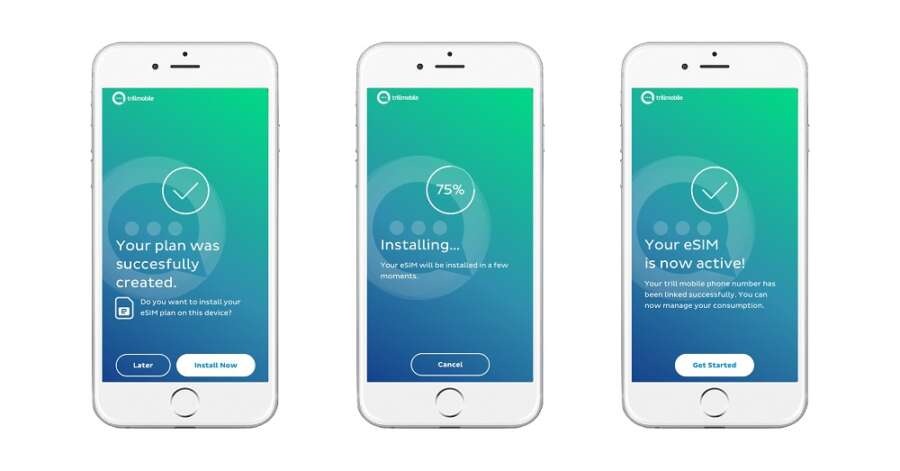
Global demand for eSIMs is skyrocketing — in 2021, there were 1.2 billion eSIM-enabled devices, and this figure is expected to rise to 3.4 billion by 2025. In recent years the world of work has changed at a rapid pace and businesses face the challenge of determining which new technology is right for them. Here Hamish White, CEO of eSIM as a Service provider Mobilise, explains how eSIMs can help manage employees and provide business opportunities.
For decades, SIM cards with a programmable IC chip called a Universal Integrated Circuit Card (UICC) have been used to store authentication parameters, including subscriber credentials and network authentication. At a time when it feels as though everything can be done virtually — from holding a meeting to taking a museum tour — it seems strange that there is still heavy reliance upon physical SIM cards.
An eSIM is a SIM card that is embedded in a mobile device and can connect the user to any operator offering eSIM services, eliminating the need for a physical UICC. It is pre-installed in the device and users can easily activate it by installing the “eSIM profile” of a new operator, removing the need for delivery waits and in-person identity verification.
Efficient business operations
With remote and hybrid working commonplace around the world, businesses must now learn to manage a workforce scattered across the globe. For remote workers, productivity is highly dependent upon their ability to connect and communicate without delay. But according to a Slack study, 24 per cent of respondents reported unstable connectivity as a challenge to remote work.
Employees working from home are often faced with unstable Wi-Fi connections and field workers may have to switch from one provider to another to maintain connectivity if their location is particularly remote. Multiple mobile services can be stored on a single eSIM-capable device, so mobile data can always be accessed when required and users can select the plan that gives them the best connectivity.
eSIM technology enables increased flexibility across the workforce. Businesses can set up different profiles with distinctive subscription plans, according to individual requirements. For example, employees working from home will likely require fewer data plans than those in the field. Previously, this would have caused IT managers a headache, but now companies can easily set up different profiles depending on unique requirements. If an employee’s circumstances and data needs change, their subscription can easily be altered in minutes.
Business trips abroad are great for improving relationships but can be a logistical nightmare if you don’t have the right technology in place. eSIMs eliminate the need to purchase a new SIM card when an employee travels abroad. eSIM can trigger a localisation service with the flexibility to choose a new local custom SIM profile (CSP) to remotely provision and activate a new subscription to the device when needed, over the air. All customers need to do is activate their eSIM. While this can be done through QR codes, for a better customer experience (CX), service providers could offer customers in-app provisioning to activate their eSIM-enabled subscription in just one tap.
The thought of changing network provider can be daunting for a company with employees around the world, as physical SIM cards must be shipped to each worker. eSIM technology streamlines and simplifies the management of enterprise devices. Network authentication credentials that have traditionally been included on the physical SIM card, are downloaded to the device Over the Air, for complete digital onboarding.
Embedded connectivity
Communications Platform as a Service (CPaaS) is a cloud-based technology that enables businesses to enrich customer communication channels. CPaaS enables businesses to embed communications services into consumer applications through the use of applications programming interfaces (APIs).
While CPaaS is typically employed in IoT device applications, there’s also scope to adopt CPaaS in consumer services to embed communication into a business’ application. For example, through CPaaS, banks can integrate chat, video or call functions directly into their mobile application, rather than directing the user to their phone’s call application. This business opportunity can streamline and significantly improve the customer service experience.
The CPaaS model can be applied to consumer services, providing potential for expanding business offerings. It is possible to take a full telecommunications network capability and embed it into any application. For example, streaming services like Netflix could offer subscribers a connectivity service by adding eSIM capability directly into their apps as part of its service offering. This would allow users to stream content without a mobile data plan, to offer a seamless user experience (UX).
Businesses’ eSIM hero
eSIM as a Service consists of Mobilise’s white-labelled digital platform, HERO, and Oasis Smart SIM’s eSIM DP and infrastructure, compliant with SAS-SM certification by the Global System for Mobile Communications Association (GSMA). As a fully customisable, modular platform, HERO’s digital interfaces allow for easy onboarding via in-app eSIM provisioning.
eSIM as a Service provides a simple, intuitive experience that allows businesses to manage their employee’s subscriptions entirely through digital channels. The customisable platform provides a personalised user experience to meet every business’s unique requirements.
Physical SIM cards cause significant logistical problems for many businesses. From managing employees more effectively to attracting customers with better sustainability credentials and embedding connectivity into apps, it is evident that the rising popularity of eSIMs is well justified.


